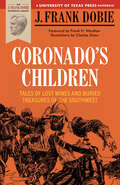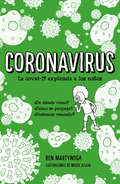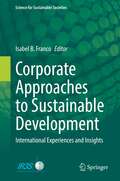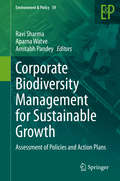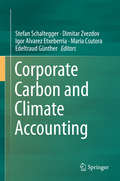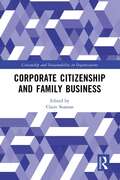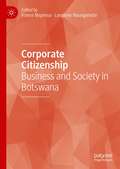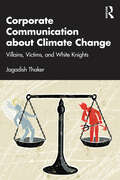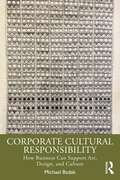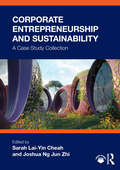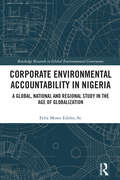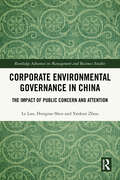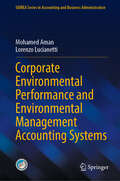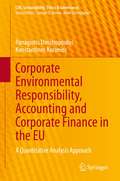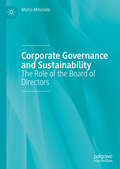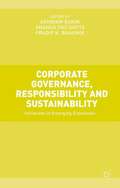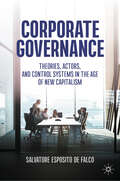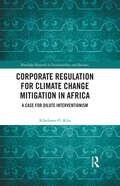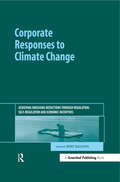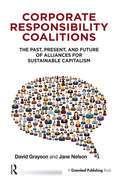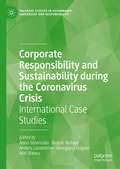- Table View
- List View
Corona, Climate, Chronic Emergency: War Communism in the Twenty-First Century
by Andreas MalmWhat does the COVID 19 tell us about the climate breakdown, and what should we do about it?The economic and social impact of the coronavirus pandemic has been unprecedented. Governments have spoken of being at war and find themselves forced to seek new powers in order to maintain social order and prevent the spread of the virus. This is often exercised with the notion that we will return to normal as soon as we can. What if that is not possible? Secondly, if the state can mobilize itself in the face of an invisible foe like this pandemic, it should also be able to confront visible dangers such as climate destruction with equal force. In Corona, Climate, Chronic Emergency, leading environmental thinker, Andreas Malm demands that this war-footing state should be applied on a permanent basis to the ongoing climate front line. He offers proposals on how the climate movement should use this present emergency to make that case. There can be no excuse for inaction any longer.
Coronado's Children: Tales of Lost Mines and Buried Treasures of the Southwest (Barker Texas History Center Series)
by J. Frank DobieWritten in 1930, Coronado's Children was one of J. Frank Dobie's first books, and the one that helped gain him national prominence as a folklorist. In it, he recounts the tales and legends of those hardy souls who searched for buried treasure in the Southwest following in the footsteps of that earlier gold seeker, the Spaniard Coronado. "These people," Dobie writes in his introduction, "no matter what language they speak, are truly Coronado's inheritors. . . . l have called them Coronado's children. They follow Spanish trails, buffalo trails, cow trails, they dig where there are no trails; but oftener than they dig or prospect they just sit and tell stories of lost mines, of buried bullion by the jack load. . . " This is the tale-spinning Dobie at his best, dealing with subjects as irresistible as ghost stories and haunted houses.
Coronavirus: La covid-19 explicada a los niños
by Ben Matynoga¿Cómo un virus tan pequeño y frágil ha logrado cambiar el mundo? Coronavirus, el libro ilustrado que explica a los niños todo lo que deben saber sobre la covid-19. Escrita por el científico Ben Martynoga. ¿De dónde viene? ¿Cómo se propaga? ¿Podemos vencerlo? El coronavirus es 15.000 veces más pequeño que una pulga y podemos matarlo con una pastilla de jabón. ¿Cómo un virus pequeño y frágil cambió el mundo? Sumérgete en el fascinante mundo de los virus junto al científico Ben Martynoga y descubrirás cosas divertidas y a la vez aterradoras de la pandemia que ha cambiado el mundo. Una fascinante historia sobre cómo las células humanas han sido secuestradas por un virus y sobre cómo nuestro cuerpo responde. En el camino, aprenderás qué son los virus, cómo funcionan y cómo podemos vencerlos, o al menos, aprender a convivir con ellos.
Corporate Approaches to Sustainable Development: International Experiences and Insights (Science for Sustainable Societies)
by Isabel B. FrancoThis book aims to answer the question: how can the industry action international approaches to corporate sustainability, ultimately achieving sustainable development and overall sustainability? With this question in mind, this manuscript examines how the industry, through existing approaches to corporate sustainability, contribute to addressing conflicting demands emerging from the achievement of sustainable development in a responsible, sustainable and innovative manner. It also reviews alternative models of corporate sustainability that contribute to achieving inclusive, sustainable development globally. Chapters 2 to 4 discuss emerging approaches to corporate sustainability. Chapters 5 to 11 examine the role that the extractive industry (mining and oil) could play in the delivery of sustainable solutions for the communities and environment in selected cases, in the Americas and Africa. Lastly, the manuscript showcases international corporate sustainability and climate change practices in the forestry, agriculture, tourism and manufacturing industries within the context of Asia and The Pacific region, particularly, Nepal and Bangladesh.
Corporate Biodiversity Management for Sustainable Growth: Assessment of Policies and Action Plans (Environment & Policy #59)
by Amitabh Pandey Ravi Sharma Aparna WatveThis book aims to cover the multitude of corporate approaches towards mainstreaming biodiversity conservation and ecological management in policies and action plans, and explores the roles of these efforts in achieving national and global targets for the Sustainable Development Goals (SDGs). The book addresses various aspects of corporate actions such as corporate environmental responsibility, green businesses, market-based approaches to biodiversity conservation, and biodiversity trade-offs, and includes concept papers, reviews, and case studies presenting qualitative and quantitative research. Additionally, the text compares and assesses examples of positive and negative impacts of corporate involvement in biodiversity conservation in developed and developing countries to identify innovative approaches, and the best practices and models that can be replicated in diverse environmental conditions. The studies included in the book will help those working in the field of corporate involvement in biodiversity conservation, and outline the strengths and weaknesses of the approaches which will be useful for designing new environmental management action plans in the face of climate change. The book will also be of great value to researchers, academicians, policy makers, civil society groups, policy think tanks, and conservation managers.
Corporate Carbon and Climate Accounting
by Stefan Schaltegger Dimitar Zvezdov Igor Alvarez Etxeberria Maria Csutora Edeltraud GüntherThis volume is devoted to management accounting approaches for analyzing business benefits and costs of climate change. It discusses future directions on carbon accounting, performance measurement and reporting as well as links between climate accounting and business processes, product and service development, supply chain innovation, economic successes and stakeholder relations. Companies are increasingly called on to contribute to combatting climate change and also face the challenges presented by climate-change related costs, risks and benefits. Risks can result from unpredictable weather conditions and government regulations, such as the EU emission trading system and new building codes. Climate change also offers numerous opportunities, such as energy efficiency innovations and carbon neutral products and production. Good management requires that carbon emissions are tracked and climate-related costs, risks and benefits are identified, measured and assessed. As such, research addressing corporate accounting frameworks and tools is of increasing importance when it comes to managing these carbon and climate-related issues.
Corporate Citizenship and Family Business (Citizenship and Sustainability in Organizations)
by Claire SeamanCurrent models of corporate citizenship largely consider business as one coherent entity. This view of business as a corporate force overlooks the growing evidence that most businesses are run by families. Family businesses are the most common form of business in existence – across countries, continents and geopolitical divides – and yet we know remarkably little about their approach to corporate citizenship. Where families run businesses, they create a concentration of family values that – for good or ill – influence the way business practices and behaviours develop. The role of the family in business has, therefore, an influence on the development of society that is partially mediated through corporate citizenship. This book pulls together current thinking from several diverse research fields that intersect with family business research to offer insight into current research and examples of practice for those studying and researching in the fields of family business, business values and corporate practice. The book will also explore the fact that family businesses tend to take a longer-term approach to business and that this is reflected in their behaviour towards the environment, community engagement, employee development and innovation. Bringing together contributions from researchers in the diverse fields of family business, philanthropy, community engagement, corporate social responsibility, innovation and policy, this book explores the many ways in which family businesses contribute to the corporate citizenship agenda.
Corporate Citizenship: Business and Society in Botswana
by France Maphosa Langtone MaunganidzeThis book discusses corporate citizenship, corporate responsibility and business ethics across Africa generally, and Botswana specifically. It begins by contextualizing Botswana within the broader context of Africa, using nine other countries – Angola, Cameroon, Ghana, Kenya, Nigeria, South Africa, Zambia and Zimbabwe – to provide a comparative perspective, examining the common factor: that weak legalization makes it challenging for corporate social responsibility to be actualized.From this background, the book then discusses Botswana as a key study. Botswana has been described as ‘Africa’s economic miracle’ due to its growing economy since independence This puts it in a unique position for the implementation and study of corporate social responsibility. The interdisciplinary team of authors employ various research methods to examine the complex relationship between business, society, corporations and social justice issues.This book will be valuable reading for any academic working on corporate social responsibility in Africa, and will present an interesting insight to an often neglected area of study. France Maphosa is a Professor of Sociology at the University of Botswana. His research interests include migration and transnationalism, the sociology of entrepreneurship, corporate social responsibility, urban and rural livelihoods, labour studies and alternative dispute resolution (ADR).Langtone Maunganidze is a Senior Lecturer in the Faculty of Social Sciences at the Midlands State University in Zimbabwe. His research interests include industrial sociology, business and society, rural livelihoods and sustainable development, and entrepreneurship.
Corporate Communication about Climate Change: Villains, Victims, and White Knights
by Jagadish ThakerEmbedded in the emerging field of climate change communication, Thaker provides a comprehensive analysis of enablers and barriers to corporate action on climate change, business role and influence on media coverage of climate change, and its impact on public opinion and the policy-making process.Focusing on extensive academic research, business reports, case studies, and best practices from around the world, this book offers a practical guide to effective strategies in corporate climate change communication, including leadership communication, rebuilding public trust amidst greenwashing scandals, and engaging stakeholders with business action on climate change. The book provides new directions on the role of social media influencers, artificial intelligence, and big data in enhancing transparency in business actions and effective communication with key stakeholders.This book is an essential read for students, scholars, and professionals interested in the emerging fields of climate change communication, strategic communication, and related areas of sustainability and Environmental, Social, and Corporate Governance (ESG) communication.
Corporate Cultural Responsibility: How Business Can Support Art, Design, and Culture
by Michael BzdakIs corporate investing in the arts and culture within communities good business? Written by an expert on the topic who ran the Corporate Art Program at Johnson & Johnson, the book sets out the case for business patronage of the arts and culture and demonstrates how to build an effective program for businesses to follow. As companies seek new ways to add value to society, this book places business support of the arts in a corporate social responsibility context and offers a new concept: Corporate Cultural Responsibility. It discusses the issues underlying business support of the arts and explores new avenues of collaboration and value creation. The framework presented in the book serves as a guide for identifying the key attributes and projected impact of successful and sustainable models. Unlike other books centered on the relationship of art and commerce, this book looks at the broader and global implications of Corporate Cultural Responsibility. It also usefully sets the discussion about the role of philanthropy and corporate social responsibility and the arts within an historical timeframe. As the first book to link culture to community responsibility, the book will be of particular relevance to corporate art advisors and auction houses, as well as students of arts management and corporate social responsibility at advanced undergraduate and postgraduate levels.
Corporate Entrepreneurship and Sustainability: A Case Study Collection
by Sarah Lai-Yin Cheah Joshua Ng Jun ZhiThis book provides detailed case studies exploring how industry-leading organizations are integrating corporate innovation and sustainability initiatives.The book first introduces the difficulties and importance of managing innovation within established organizations. It identifies five themes key for organizations seeking to future-proof their business: external drivers in the business environment, structures for corporate entrepreneurship, modes of collaboration, sustainability as a lever for innovation, and performance management. It then provides detailed case studies of how companies across diverse sectors, such as banking, shipping, and real estate, made the choice between short-term profit and future-proofing their business. Cases are written such that they can be used independently, and a storytelling approach is used so that readers may apply the conceptual frameworks and see how theories are translated into practice. Detailed teaching notes are available for instructors, each containing a sample lesson plan, six discussion questions, suggested answers, and further readings.A useful teaching resource for instructors and students in corporate entrepreneurship, corporate innovation, and strategic foresight.
Corporate Environmental Accountability in Nigeria: A Global, National and Regional Study in the Age of Globalization (Routledge Research in Global Environmental Governance)
by Felix Moses EdohoThis book examines the imperative role of global environmental governance, and the need to incorporate corporate environmental accountability and mechanisms for enforcement, to effectively address the global environmental crisis. The author, Felix Moses Edoho, Sr., examines the issues at the various global, national, and regional levels. In Part I the book examines the issues at the global level and looks at the impact of transnational corporations (TNCs) and globalization on the global environmental crisis. Furthermore, it also examines the efforts of the United Nations in initiating global environmental architecture to tackle the crisis. Part II considers the issues at the national level and focuses on Nigeria. The author explores Nigeria’s regulatory and institutional framework for environmental governance and implementation. Lastly, at the regional level in Part III, the discourse centers on how decades of oil exploration and production have unleashed monumental ecological tragedies in the Niger Delta region of Nigeria due to the lack of corporate environmental accountability. This book will be of great interest to academics and students who are interested in broadening their knowledge of environmental governance and policy in developing countries. It will also be of value to environmental regulatory agencies and public administrators, development professionals, and TNCs.
Corporate Environmental Accountability in Nigeria: A Global, National and Regional Study in the Age of Globalization (Routledge Research in Global Environmental Governance)
by Felix Moses EdohoThis book examines the imperative role of global environmental governance, and the need to incorporate corporate environmental accountability and mechanisms for enforcement, to effectively address the global environmental crisis.The author, Felix Moses Edoho, Sr., examines the issues at the various global, national, and regional levels. In Part I the book examines the issues at the global level and looks at the impact of transnational corporations (TNCs) and globalization on the global environmental crisis. Furthermore, it also examines the efforts of the United Nations in initiating global environmental architecture to tackle the crisis. Part II considers the issues at the national level and focuses on Nigeria. The author explores Nigeria’s regulatory and institutional framework for environmental governance and implementation. Lastly, at the regional level in Part III, the discourse centers on how decades of oil exploration and production have unleashed monumental ecological tragedies in the Niger Delta region of Nigeria due to the lack of corporate environmental accountability.This book will be of great interest to academics and students who are interested in broadening their knowledge of environmental governance and policy in developing countries. It will also be of value to environmental regulatory agencies and public administrators, development professionals, and TNCs.
Corporate Environmental Governance in China: The Impact of Public Concern and Attention (Routledge Advances in Management and Business Studies)
by Le Luo Hongtao Shen Yankun ZhouThe book explores how diverse stakeholder groups—particularly community and regulatory stakeholders—shape corporate environmental practices. Focusing on one of the world’s largest economies, this book provides an in-depth analysis of stakeholder dynamics and their impact on corporate environmental performance and disclosure.Environmental governance has become a global imperative as environmental crises intensify and stakeholder expectations grow. The book examines the interplay between community advocacy and regulatory actions and particularly focuses on how community stakeholders drive corporate accountability by pressuring regulatory authorities to enforce stricter measures or provide financial incentives. The chapters include discussions on the role of public environmental awareness and concern in shaping corporate performance and disclosure practices. The book also highlights how regulatory influence mediates the relationship between community influence and corporate environmental outcomes, offering new insights into the interactive dynamics of stakeholder influence.This book will be of interest to policymakers, corporate managers, and academics seeking to understand the nuanced relationships between businesses, governments, and communities. It offers actionable recommendations for fostering effective environmental governance and sustainable corporate practices.
Corporate Environmental Performance and Environmental Management Accounting Systems (SIDREA Series in Accounting and Business Administration)
by Mohamed Aman Lorenzo LucianettiThis book provides insights into the role of environmental management accounting practices and the impact of various governance aspects dedicated to the environment in enhancing corporate environmental performance. It also examines the extent of environmental disclosure based on organizational-level data from Italian listed firms. These mechanisms work together to influence policies and management decisions, particularly in guiding businesses towards more sustainable choices. The book suggests that firms can use robust and versatile governance mechanisms to improve managerial oversight by incorporating diverse viewpoints, ideas, perspectives, and abilities into the decision-making process. This, in turn, may lead to better performance. Effective governance drives change towards a cleaner environment by tapping into untapped potential, such as eco-friendly operations, and optimizing resource utilization. Additionally, the book emphasizes the role of environmental management accounting systems in helping firms better coordinate, measure, and manage their capabilities, thereby achieving improved environmental performance.
Corporate Environmental Responsibility, Accounting and Corporate Finance in the EU: A Quantitative Analysis Approach (CSR, Sustainability, Ethics & Governance)
by Panagiotis Dimitropoulos Konstantinos KoroniosThe purpose of this book is to study the association of corporate environmental responsibility (CER) with financial performance, capital structure, innovative activities, corporate risk, working capital management and accounting quality. Undoubtedly, CER has been developed into a crucial corporate issue around the world. CER has been incorporated within various sectors, countries and includes many types of activities and dimensions. A fundamental issue that is addressed in this book, is how corporate finance and accounting are affected by CER activities and how it impacts company performance. In order to analyse this interrelation, the authors focus on a sample of firms from 28 EU member countries. The purpose of this book is to study the association of CER with financial performance, capital structure, innovative activities, corporate risk, working capital management and accounting quality. The book also intends to provide useful policy recommendations as well as to offer constructive impulses for future research.
Corporate Environmental Strategies and Value Creation: Challenges and Opportunities (SpringerBriefs in Business)
by Rosita CapurroThe rise of sustainability has swept away the traditional views about firms’ competitiveness, survival and profitability, advocating new approaches. Although the strategic decisions on sustainable issues become more important, many firms have erroneously narrow view of environmental strategies and related practices generally have only an outward-looking focus. In line with these considerations, this book aims to investigate the “environmental dimension” as a new “strategic variable” for contributing to strengthen the competitive positioning of firms and to increase the value creation process. The author provides a comprehensive framework for green management by highlights practices and tools to translate strategy into effective environmental ideas. The focus is on goals and actions, from a side, and on the implementation of appropriate control systems useful for monitoring the results of environmental performance, on the other. As such, the book enriches sustainability literature, offers new insights for scholars, and provides implications for practitioners involved in green management.
Corporate Environmental Strategy: Theoretical, Practical, and Ethical Aspects (SpringerBriefs in Applied Sciences and Technology)
by Voicu D. DragomirThis book is a first step towards understanding the complexity of corporate environmental strategy while explaining the relationships between the numerous dimensions of the concept. When we think of corporate environmental strategy, we usually have in mind a dull and stereotypical statement issued by the CEO, addressing aspects such as pollution reduction, stakeholder dialogue, and unfailing care for the environment. However, genuine environmental protection relies on proactive policies, managerial commitment, cleaner technologies, and advanced management procedures. The author identifies a series of environmental strategy dimensions, some of which have been thoroughly researched in the literature, whereas others have only emerged in recent years. The main dimensions presented in this book include corporate environmental performance; environmental accounting and disclosure; environmental management practices; greening the supply-chain; environmental values and responsibility; green entrepreneurship and innovation; environmental training, culture and policies; and environmental legitimacy and reputation. For each dimension, the author develops a discussion framework, which provides the necessary operational definitions, methodological implications, and practical situations in which these constructs can be used. Each section contains a visual representation of the relationships between the dimensions of corporate environmental strategy and the actions of decision-makers and relevant stakeholders.
Corporate Governance and Sustainability: The Role of the Board of Directors
by Marco MinciulloThis book discusses the implementation of sustainability in corporate governance mechanisms since 2013 and assesses how much the role of the Board of Directors has changed as a result. The study explores the impact of legislation upon corporate governance in two European contexts, the UK and Italy, which have been affected differently by changes in national regulations since 2013. This investigation relies first on the analysis of interviews administered to the boards of directors of Italian firms, to highlight how far sustainability objectives were considered a real priority for their firms and how their role evolved in terms of specific duties and practices. Second, thanks to a rich dataset from 2013 to 2017, the investigation considers the corporate governance reports of top Italian and British listed firms, to identify how the integration of sustainability within corporate governance has been evolving since 2013, and how it has been disclosed. This insider perspective provides the reader with a set of tools useful for analysing firms’ engagement towards sustainability, and for assessing whether listed firms practice what they preach.
Corporate Governance, Responsibility and Sustainability: Initiatives In Emerging Economies
by Arindam Banik Ananda Gupta Pradip BhaumikCorporate Governance, Responsibility and Sustainability investigates various dimensions of corporate governance issues in key emerging economies such as China, India, Brazil, South Africa and Russia. The book explores a number of issues in the areas of corporate governance framework, market discipline and building an efficient, competitive market.
Corporate Governance: Theories, Actors, and Control Systems in the Age of New Capitalism
by Salvatore Esposito De FalcoIn an era marked by financial scandals, corporate crises, and rapid technological advancements, this textbook equips readers with the knowledge and tools necessary to navigate the complexities of corporate governance effectively. Divided in three thematic sections, it offers a thorough examination of corporate governance theories, key actors and the systems of control essential in the current era of 'New Capitalism'. The chapters go beyond theoretical concepts, featuring numerous practical case studies drawn from real-world scenarios. Whether used as a textbook in academic settings, a reference guide in professional contexts, or a self-study resource, this textbook caters to diverse learning needs and preferences. Its organized structure and accessible language make it suitable for individuals at various stages of their academic or professional journey.
Corporate Regulation for Climate Change Mitigation in Africa: A Case for Dilute Interventionism (Routledge Research in Sustainability and Business)
by Kikelomo O. KilaThis book critically analyses the prospects of overhauling the legal framework of climate change regulation of corporations in African state. It adopts the dilute interventionism regulatory framework to tackle the culture of regulatory resistance by corporations in Africa. Over the course of this volume, Kikelomo O. Kila critiques the climate change legal framework in all 53 African states and conducts an in-depth case study of the two largest economies in Africa – Nigeria and South Africa – to highlight the commonality of the problems in Africa and the potential for the dilute interventionism paradigm to significantly address these problems. The book establishes why African states should directly intervene through legislative mechanisms to compel corporations to incorporate climate change mitigation in their business activities. It proposes that this direct intervention should comprise a blend of prescriptive and facilitative mechanisms structured in a dilute interventionism regulatory model. Overall, this volume argues that implementing this model requires the institution of a strong and independent regulator with a veto firewall protection system that guarantees its de facto independence from government and external influences. Corporate Regulation for Climate Change Mitigation in Africa will be of great interest to climate change stakeholders at the international, regional, and domestic levels, policymakers, regulatory practitioners, and legal experts on corporate regulation. It will also be an insightful resource for students and scholars of climate change and environmental law, policy, and governance.
Corporate Responses to Climate Change: Achieving Emissions Reductions through Regulation, Self-regulation and Economic Incentives
by Rory SullivanGiven the scale of the greenhouse gas emissions reductions that are seen as necessary to avert the worst effects of climate change, policy action is likely to result in a complete reshaping of the world economy. The consequences are not confined to 'obvious' sectors such as power generation, transport and heavy industry; virtually every company's activities, business models and strategies will need to be completely rethought. In addition, beyond their core business activities, companies have the potential to make important contributions to reducing greenhouse gas emissions through the allocation of capital, through innovation and the development of new technologies, and through their influence on the actions taken by governments on climate change.Corporate Responses to Climate Change has been written at a crucial point in the climate change debate, with the issue now central to economic and energy policy in many countries. The book analyses current business practice and performance on climate change, in the light of the dramatic changes in the regulatory and policy environment over the last five years. More specifically, it examines how climate change-related policy development and implementation have influenced corporate performance, with the objective of using this information to consider how the next stage of climate change policy – regulation, incentives, voluntary initiatives – may be designed and implemented in a manner that delivers the real and substantial reductions in greenhouse gas emissions that will be required in a timely manner, while also addressing the inevitable dilemmas at the heart of climate change policy (e.g. how are concerns such as energy security to be squared with the need for drastic reductions in greenhouse gas emissions? Can economic growth be reconciled with greenhouse gas emissions? Can emissions reductions be delivered in an economically efficient manner?).The book focuses primarily on two areas. First, how have companies actually responded to the emerging regulatory framework and the growing political and broader public interest in climate change? Have companies reduced their greenhouse gas emissions and by how much? Have companies already started to position themselves for the transition to a low-carbon economy? Does corporate self-regulation – unilateral commitments and collective voluntary approaches – represent an appropriate response to the threat presented by climate change? What are the barriers to further action? Second, the book examines what the key drivers for corporate action on climate change have been: regulation, stakeholder pressure, investor pressure. Which policy instruments have been effective, which have not, and why? How have company actions influenced the strength of these pressures?Corporate Responses to Climate Change is a state-of-the-art analysis of corporate action on climate change and will be essential reading for businesses, policy-makers, academics, NGOs, investors and all those interested in how the business sector is and should be dealing with the most serious environmental threat faced by our planet.
Corporate Responsibility Coalitions: The Past, Present, and Future of Alliances for Sustainable Capitalism
by David Grayson Nelson JaneThe significance of business-led corporate responsibility coalitions is indisputable. The WBCSD has 200 member companies with combined annual revenues of US$7 _trillion_; the UN Global Compact has almost 8,000 corporate members, over two-thirds of them from developing countries. It is estimated that there are more than 110 national and international generalist business-led CR coalitions. But there is now urgent need for informed and balanced analysis of their achievements, their progress and their potential.Why did these coalitions start and grow? What have been their impacts? Where are they heading now? Where should they be going? What is the future? In a period of austerity, the business and public sector must decide whether funding these coalitions is a priority.To meet current crises, there will have to be a great deal more business involvement; but efforts of individual corporations will not be sufficient. There is also a need for far more collective action among companies and more collaborative action between different sectors of society. Business-led CR coalitions with their decades of convening experience could play an important role in this process - if they are fit for purpose going forward.Authors David Grayson and Jane Nelson have been actively involved in such coalitions for decades. In Corporate Responsibility Coalitions they first explore the past, present and future of these coalitions: the emergence of new models of collective corporate action over the past four decades; the current state of play, and the increasing number, diversity and complexity in terms of how they not only network with each other but also engage in a much broader universe of institutions that are promoting responsible business practices. In addition, the book provides in-depth profiles of the most strategic, effective and long-standing coalitions, including: Business for Social Responsibility; Business in the Community; CSR Europe; Instituto Ethos; International Business Leaders Forum; the UN Global Compact; and the WBCSD.This book will be required reading for key supporters and potential partners of such coalitions in companies, governments, international development agencies, foundations, non-governmental organizations, academic institutions and think-tanks. It also aims to inspire a future generation of leaders to be more aware of the role of business as a partner in driving more inclusive, green and responsible growth, and to help them develop new types of leadership skills so that they can be effective in finding multi-stakeholder solutions to complex and systemic challenges.
Corporate Responsibility and Sustainability during the Coronavirus Crisis: International Case Studies (Palgrave Studies in Governance, Leadership and Responsibility)
by Anders Lundström Georgiana Grigore Alin Stancu Anna Sörensson Besrat TesfayeThis book seeks to understand how society and businesses are affected by, and respond to, the coronavirus crisis in various parts of the world. The volume explores: new CSR perspectives given the pandemic situation; SME perspectives and responsibility during the early stages of the pandemic; how large companies responded to the crisis; the challenges and opportunities provided by the use of digital technologies; and how leaders, entrepreneurs and individuals manage in uncertain times.Pulling together conceptual and empirical studies from Spain, Mexico, Sweden, Nigeria, Ghana and Kuwait , the book offers a truly international perspective as it examines how the pandemic has challenged a number of existing CSR assumptions, concepts and practices. It will be valuable reading for academics working in the fields of management, CSR, sustainability and crisis management.Anna Sörensson is assistant professor and researcher in Department of Economics, Geography, Law and Tourism at Mid Sweden University, Sweden.Besrat Tesfaye is Associate Professor of Business Administration at Södertörn University, Sweden.Anders Lundström is professor emeritus at Mid Sweden University and managing director at the IPREG (The Institute of Innovative Entrepreneurship), Sweden.Georgiana Grigore is Associate Professor in Marketing at University of Leicester, UK.Alin Stancu is Professor at the Bucharest University of Economic Studies, Romania.

